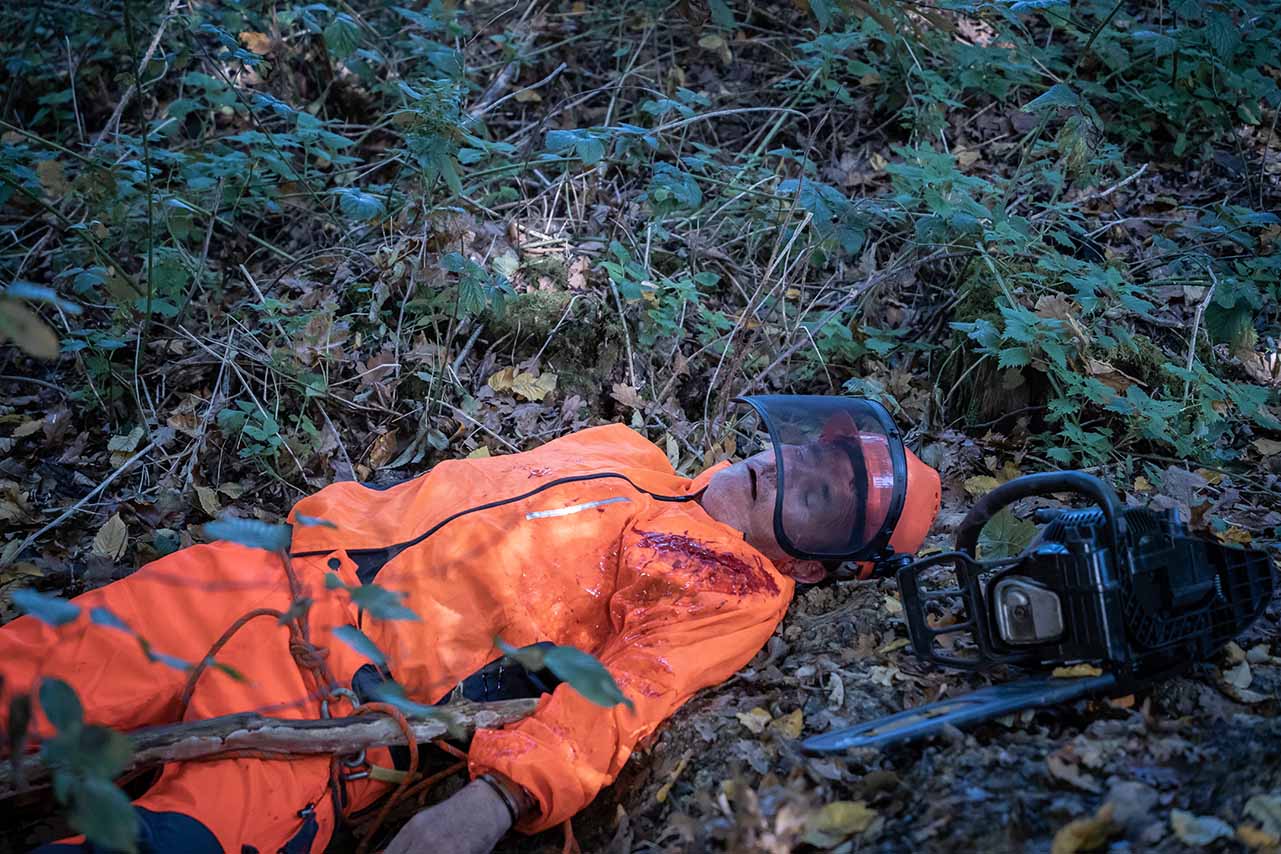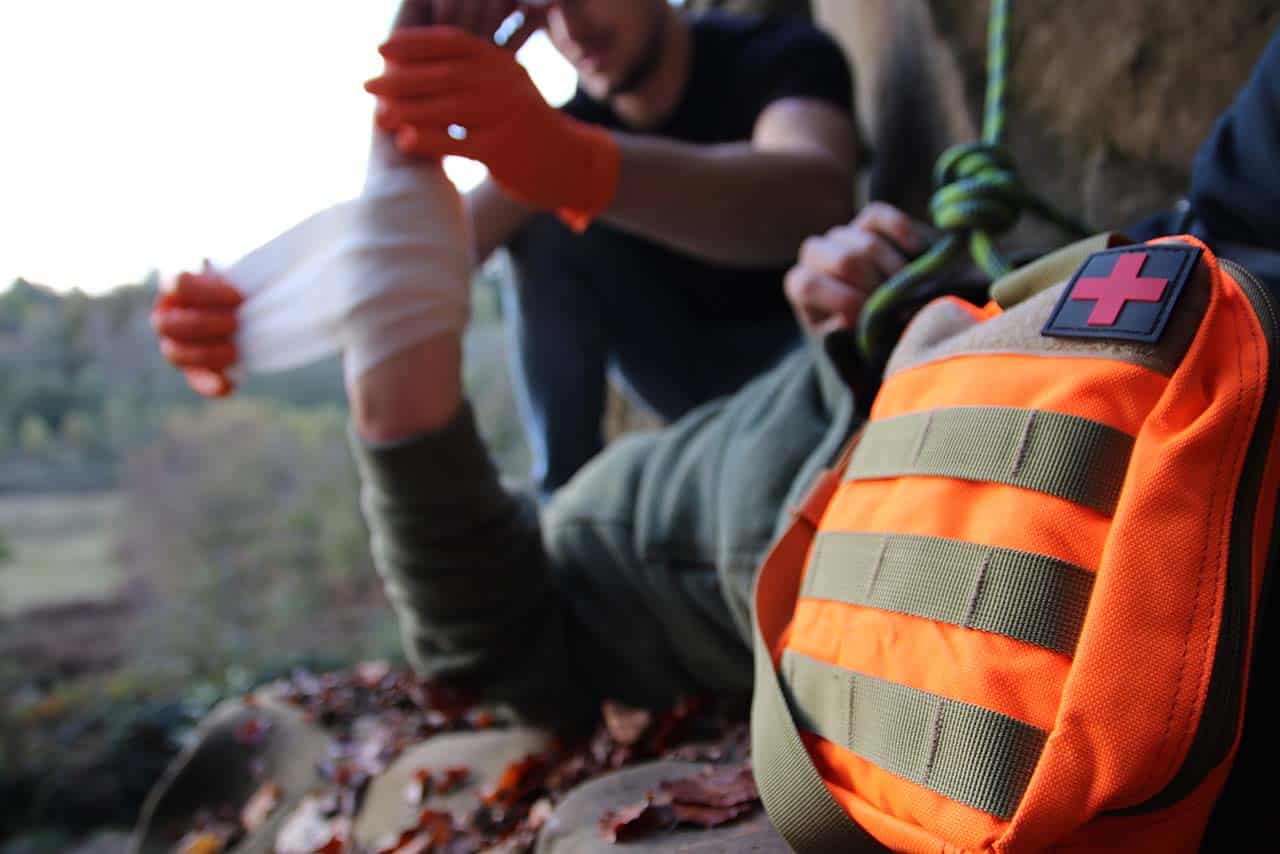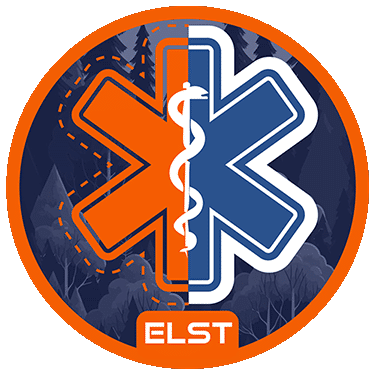Sussex Forestry First Aid

This guide will provide you with the legal background to foresty first aid provision at work in Sussex (for staff, contractors, volunteers, and some 3rd parties) and outlines further information that will assist you with delivering the essential first aid requirements. Contractors such as hauliers, arborists, tree surgeons, and others wishing to work on Forest Services or Forestry England land will need to show that they comply with the requirements set out in the Planning Policy Guidance 59.
People, wherever they work or recreate, can suffer injury or be taken ill. It is essential that a reasonable level of first aid provision is in place so that they can be given appropriate attention and an ambulance can be called if needed. Proper first aid provision can and does save lives.
There are three main elements to satisfy the First Aid legislation in the workplace from the Health & Safety Executive and Forestry England.
1. Which Forestry First Aid course in Sussex do I need to train my staff in?
There are two main courses which are Emergency First Aid at Work + F (EFAW+F) and First Aid at Work + Forestry (FAW +F).
2. What First Aid Kit do I need to provide?
This in our view is essential and from experience, so few companies look at this in detail.
3. What Facilities do I need to provide?
You may need to provide a suitable first-Aid room. This is only usually required for larger companies.
It is crucial to choose the correct course and forestry first aid kit and we hope this article will guide you through the process of what you need to know and do.
Firstly, We need to go through the law and try and help you gain the answers you need, which will lead to the right decision on your First Aid requirements.
ELST can provide the necessary training in Forestry First Aid for your organisation, in Sussex. Our courses fulfil the requirements of the Health & Safety Executives (First Aid) legislation and satisfy the needs of the Forestry Commission.
Before you possibly choose Emergency Life Support Team for your Foresty First Aid training in Sussex, let’s find out what course, facilities, and equipment you may need.
It is crucial to choose the correct course plus equipment and we hope this article will guide you through the process of what you need to know and do.
Firstly, We need to go through the law and try and help you gain the answers you need, which will lead to the right decision on your Foresty First Aid requirements in Sussex.
ELST can provide the necessary training in Foresty First Aid Training for your organisation, in Sussex. Our courses fulfill the requirements of the Health & Safety Executives (First Aid) legislation and the Forestry Commission.
Before you possibly choose Emergency Life Support Team for your Foresty First Aid training in Sussex, let’s find out what course, facilities and equipment you may need.

Health & Safety Legislation on First Aid in the workplace
The Health and Safety (First Aid) Regulations 1981 require employers to provide adequate and appropriate, facilities, equipment and personnel to ensure their employees receive immediate care if they are injured or taken ill at work. These Regulations apply to all workplaces including those with less than five employees and to those who are self-employed.
What is ‘adequate and appropriate’ will all depend on the circumstances in your workplace. This includes whether trained First Aiders are needed, what should be included in a First Aid kit and if a First Aid room is required. Employers should carry out an assessment of first Aid needs to determine what they should provide.
The Regulations do not place a legal duty on employers to make First Aid provisions for non-employees such as members of the public or children in schools.
HSE strongly recommends that non-employees are included in an assessment of First Aid needs and that provision is made for them.
Do you employ forestry staff in Sussex?
You have the responsibility for making sure that your employees receive immediate appropriate life-saving care if they become ill or are injured at work. Illness and Accidents can happen at any time and First Aid can be life-saving, and prevent minor injuries from becoming major ones.
As an employer what should you do?
You must make appropriate arrangements for your workplace First Aid needs. You should consider the circumstances of your workplace, workers and the health and safety risks that may be present to help you decide what arrangements you need to put in place.
Some small low-risk workplaces need to have only a First Aid box and a person appointed to take charge of First Aid arrangements such as calling the emergency services and stocking the First Aid box. The appointed person does not need specific First Aid training.
If your workplace has more significant health and safety risks, for example, you use machinery or hazardous materials then you are more likely to need a trained First Aider.
You must provide all your employees with details of the First-Aid arrangements.
Forestry First Aid needs assessment
In order to establish what provision for First Aid is required you should make an assessment of the First Aid needs appropriate to the circumstances of your workplace.
This should include consideration of:
- the workplace,
- the workforce, and
- the hazards and risks present.
You can find out more information on carrying out a First Aid needs assessment, including a suite of example case studies and an online assessment tool to help you decide what arrangements you need to put in place for First Aid.
HSE has published further guidance on all the factors above that will help you carry out your First-Aid needs assessment.
Forestry First Aid arrangements for business in Sussex
Your arrangements will depend on the outcome of your First Aid needs assessment and the particular circumstances in your workplace at any given time.
The findings of the needs assessment should indicate the level of First Aid equipment, facilities and personnel required.
As a minimum, you must have:
- a suitably stocked First Aid kit
- an appointed person to take charge of First Aid arrangements;
- information for all employees giving details of First Aid arrangements.
Where your needs assessment identifies workplace or workforce issues, or more significant health and safety risks, you are likely to need a sufficient number of appropriately trained First Aiders and may need to arrange additional equipment and facilities.
Forestry First Aiders and First Aid training in Sussex
You might decide that you need a First Aider. This is someone who has been trained by a competent First Aid training provider in First Aid at work+F, Emergency First Aid at work +F or some other appropriate level of training (identified by your needs assessment).
First Aid +F training Sussex
Working with the principle of matching skills to your possible accidents/illnesses, those working in core operations will require training that has been delivered in a forestry context (ie sites remote from medical aid and where limited help will be available). This may also be appropriate for Recreation staff working in particularly wild, rural, or rugged ends of the VSG Spectrum. This training is referred to in this guidance as EFAW+F or FAW+F. The term “+F” may not be widely recognised. Core operations mean; harvesting, civil engineering, mechanised ground preparation, planting, fencing, pesticide application, forest nursery activities, or similar. It includes any lone workers or site supervisors.
They may also need add-on elements for our special hazards (eg severe chainsaw cuts, crush injuries, hypothermia, Lyme disease). Where severe cuts are considered and First Aid haemostatic dressings or tourniquets are to be provided, staff should receive specific training on their use.
“+F” will be recognised when “forestry context” or “remote sites” or “+F” is noted on certificate or supporting correspondence.
First aiders involved in non-core operations will need a valid EFAW or FAW certificate. The +F element can be seen as desirable for non-core.
If you have identified that you need First Aiders HSE has produced guidance to help you select a competent First Aid training provider
ELST can help you by providing you with the courses you need.
Refreshing training within the 3 years
Everyone who has a first aid qualification it is recommended undertake annual refresher training in addition to 3-yearly requalification training. They should also be encouraged to regularly review their course manual and any other instructional materials, and be given time to do this. This will help them maintain their basic skills and keep up-to-date with any changes to first aid procedures.
TheHSE have stated that refresher events should be of minimum half-day duration, led by someone with current experience of first aid skills and competence to train. On-line refresher training, on its own, should not be seen as effective. For forestry or first aid for public, refresher training can usefully be based around a field exercise and should include the importance of, and arrangements for, planned emergency procedures. Importantly, if Unit Managers don’t have access to someone with current experience of first aid skills and a documented competence to train, they should use an outside provider.
Appointed persons
Where your First-Aid needs assessment identifies that a First-Aider is not required, you must appoint a person to take charge of the First Aid arrangements, including looking after the equipment and facilities, and calling the emergency services when required. An appointed person is not required to have any formal training.
It is important that someone is always available to take charge of the First Aid arrangements, including looking after the equipment and facilities and calling the emergency services when required. Arrangements should be made for an appointed person to be available to undertake these duties at all times when people are at work.

Forestry First aid and Emergency Procedures Sussex
Planning for an emergency helps you to:
- Minimise the time taken for the emergency services to reach you
- Minimise the risk to operators if there is an emergency
- Include environmental and other emergencies in your plan.
Employers and the self-employed need to assess the first aid requirements of their work. Make sure there are enough trained first aiders and facilities to help casualties of illness or injury immediately, and that an ambulance or other professional help can be summoned without delay.
You should also identify which items need to be in the worksite first aid kit.
Your Forestry First Aid assessment
Your first aid assessment should take into account of:
- The nature of the work
- The history and consequences of injuries
- The nature and distribution of the workforce
- The remoteness of the site from the emergency services, including location, terrain and weather conditions
- Working on shared or multi-occupied sites
- Holidays and other absences of first aiders
- The presence of trainees and the public
- The possibility of medical conditions or allergies.
Forestry First aid kit
You should carry a personal first aid kit on you while at work. Make sure you have received suitable training on using its contents. It should contain at least one or more haemostatic dressings, a tourniquet, a pair of plastic gloves and a Resusciade (or similar device). Keep a worksite first aid kit at a central location.
Emergency procedures
For any emergency procedures to work well, all operators and managers must aware of the procedures and have the opportunity to test them. You should test, evaluate and modify your procedures to ensure they are working. Ensure you know your location. Be able to provide OS grid references or GPS coordinates, and access points from the main road into the forest or woodland.
You should also anticipate problems that will exist in getting to a casualty, eg the need for aerial tree rescue, or releasing a casualty who is trapped below a tree or heavy equipment. Identify the personnel and equipment that need to be on site and set up how to quickly contact other people you need.
Accidents and Ill Health
Under health and safety law, you must report and keep a record of certain injuries, incidents and cases of work-related disease.
You can find out which ones must be reported and how to report them on our report an incident pages. You can find out which ones must be reported and how to report them on the HSE report an incident pages.
RIDDOR (the Reporting of Injuries, Diseases and Dangerous Occurrences Regulations 2013) puts duties on employers, the self-employed and people in control of work premises (the Responsible Person) to report certain serious workplace accidents, occupational diseases and specified dangerous occurrences (near misses)
Keeping records will help you to identify patterns in the incidence of accidents and injuries, and will help when completing your risk assessment. Your insurance company may also want to see your records if there is a work-related claim.
Remember data protection
Make sure you protect people’s personal details by storing records confidentially in a secure place.
- If you have more than 10 employees, or own or occupy a mine, quarry or factory, you must keep an accident book under social security law.
- You can buy an accident book from HSE Books or record the details in your own record system.
Quick link Resources from the Health & Safety Executive to help you as a business in Eastbourne
-
First Aid at work: Your questions answered
-
The Health and Safety (First-Aid) Regulations 1981. Approved Code of Practice and guidance
-
RIDDOR report an incident
-
Frequently asked questions on First Aid
-
What should a First-Aid box in the workplace contain
-
Forestry England – First Aid- PPG 59
Crown Copyright, courtesy Forestry Commission 31st October 2022, licensed under the Open Government Licence.
So there you have it, and I know this may take a bit of time to assess what you need to do. But trust us, it will be worth it. Knowing you are meeting your legal requirements for Forestry First Aid in Sussex at your workplace will be true peace of mind.
Andy Sullivan
Company Director
